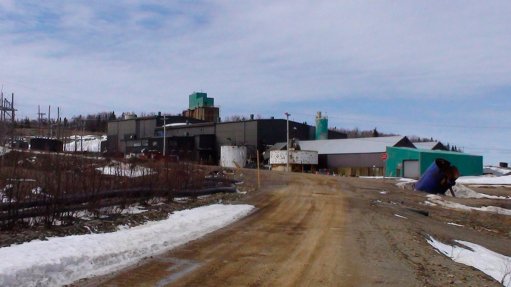
Name: Caribou mine and mill.
Location: The Caribou mine is located in Restigouche County, in the province of Brunswick, Canada.
Controlling Company: Trevali Mining Corporation.
Brief History: Caribou mine has been on care and maintenance since 2008. The previous operators of the Caribou mine and mill complex, Blue Note Metals, invested about $120-million in a major overhaul and modernisation of the processing plant and mine infrastructure between 2006 and 2008.
The mine operated for about 13 months before going into receivership in 2008, owing to depressed commodity prices and adverse global financial conditions.
In 2009, Blue Note declared bankruptcy after mining about 570 000 t. Maple Minerals acquired the Caribou property from bankruptcy and in November of 2012, Trevali acquired Maple Minerals and now controls the Caribou deposit.
Mine restart activities are expected to start in 2015.
Brief Description: The Caribou project is an advanced stage lead/zinc/copper/silver/gold deposit located on an existing mine site with extensive pre-existing infrastructure. The property is about 7 km long in the east-west direction and 5 km wide in the north-south direction. It comprises a single mining lease (ML), ML-246, covering 3 105.7 ha. The lease has a 20-year term and is set to expire on October 27, 2028.
Geology/Mineralisation: Caribou is a volcanic-sediment-hosted massive sulphide deposit and is one of more than 45 massive sulphide deposits in the Bathurst Mining Camp (BMC). The deposit is situated in the northern portion of the BMC and occurs in the core of a synformal structure that plunges steeply 80º to 85º to the north.
The Caribou deposit consists of the following units from the base upward:
• Dark grey to black carbonaceous shale, pale grey phyllite, greywacke, and chloritic schist interbedded with hydrothermally altered pale green felsic volcanic rocks (footwall of the deposit);
• Stringer sulphides cutting hydrothermally altered sedimentary and felsic volcanic rocks;
• Massive sulphides comprising a vent complex and bedded sulphides;
• Chloritic schist at the contact between massive sulphides and overlying felsic volcanic rocks; and
• Interbedded felsic volcanic and sedimentary rocks.
Resources: Total measured and indicated resources as at May 13, 2014, were 7.23-million tonnes grading 0.89 g/t of gold, 84.43 g/t of silver, 2.93% lead, 6.99% zinc and 0.43% copper. Indicated mineral resources were estimated at 3.66-million tonnes grading 1.23g/t of gold, 78.31 g/t of silver, 2.81% of lead, 6.95% of zinc and 0.32% of copper.
Products: Gold, silver, lead, zinc and copper.
Mining Method: Modified Avoca, supplemented by up hole retreat for partial sill pillar recovery.
Major Infrastructure and Equipment: The Caribou mine and mill complex includes a historically developed underground mine and a fully permitted 3 000 t/d processing mill, flotation recovery plant, metallurgical and geochemical laboratories, and a tailings management facility.
Prospects: Surface and underground development programmes at Caribou continue to advance and the project status remains on schedule for start-up commissioning in the first half of 2015.
Contact Person: VP investor relations and corporate communications, Steve Stakiw.
Contact Details:
Trevali Mining,
Tel +1 604 488 1661,
Fax +1 604 408 7499, and
Email info@trevali.com.